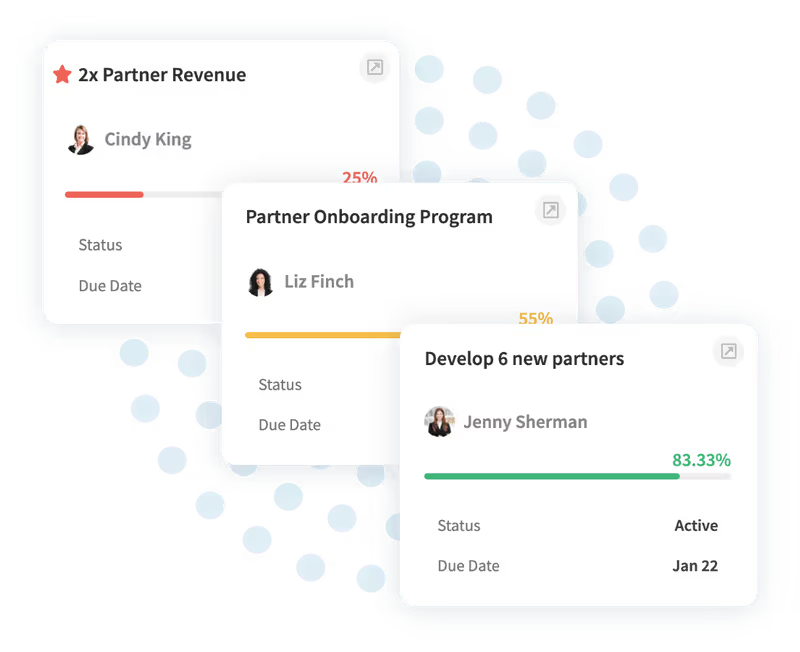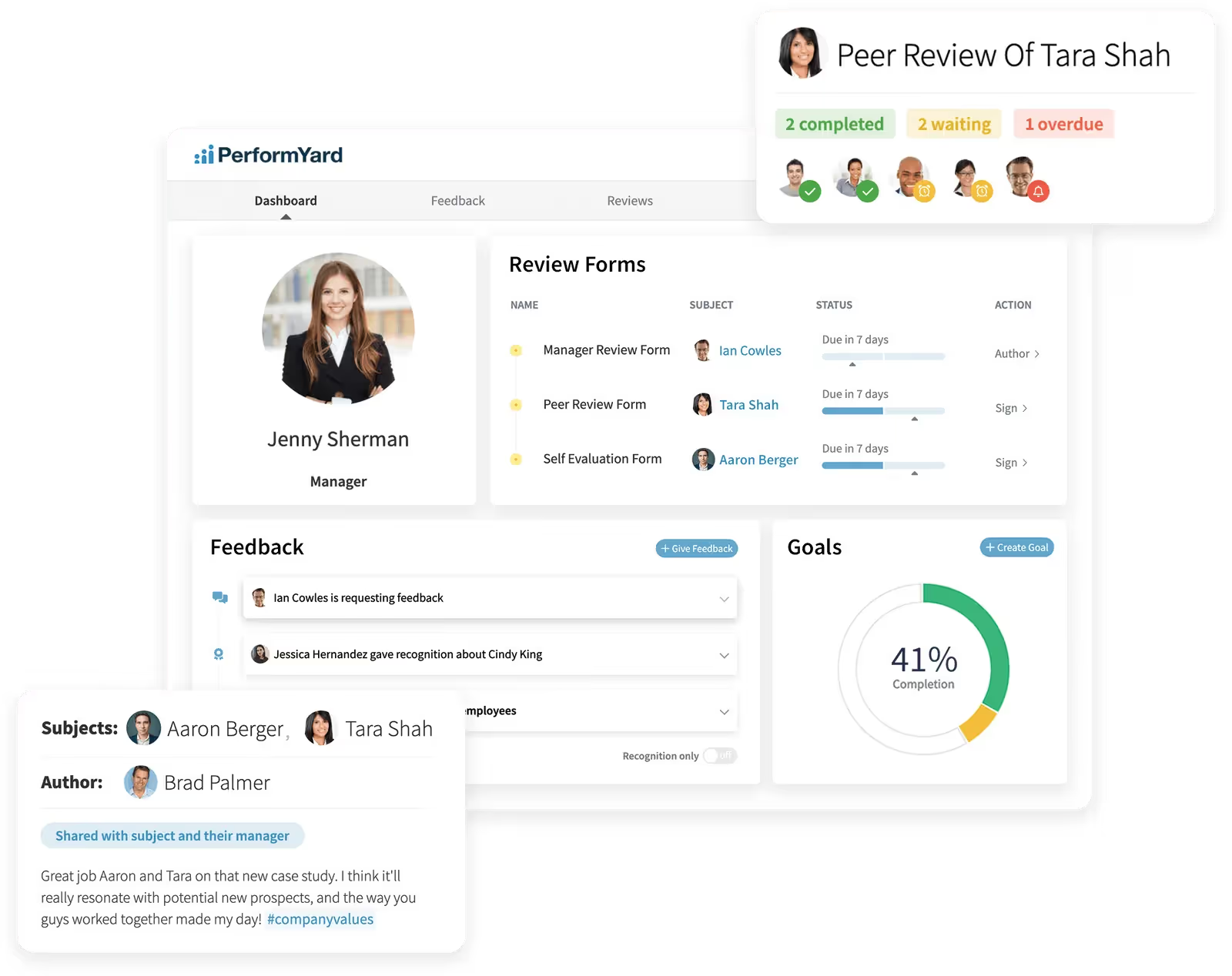How to Reduce Employee Turnover With Performance Management
At first glance, employee turnover doesn’t seem like that big of a deal. There will always be employees who come and go from your business, but replacing them costs a lot of time and a lot of money. It’s well worth it to reduce the number of employees who leave for another opportunity.
You can reduce the employee turnover rate through various strategies, like performance management, but before we get into those tips, let’s talk about the employee turnover rate, its meaning, and how to know if it’s a problem at your organization.
What Is Employee Turnover?
The employee turnover rate calculates the number of employees who leave an organization within a certain timeframe. The statistic includes employees who leave voluntarily for another job and involuntarily due to a termination or a layoff.
Your organization may find it useful to measure turnover every year or every quarter. You may also want to measure turnover among certain populations, like new hires.
What’s the difference between employee turnover and attrition? Are they the same thing?
Attrition also measures employees who exit the company, but it does not include employees who leave involuntarily. This measurement is invaluable because employees who leave by choice are looking for things like more money, career progress, better work/life balance, and more. When you know what those reasons are and you address them, you have the opportunity to encourage your employees to stay with your organization.
What Is the Cost of Employee Turnover?
You want to create a professional culture that your employees appreciate. After all, workplace atmosphere can greatly impact productivity, but that’s not the only reason why you should pay attention to employee turnover.
The cost of employee turnover is high. It can cost upwards of six to nine months of each exiting employee’s salary to replace them. That's between $30,000-$45,000 for an employee who makes $60,000 each year. If you have more than one employee who leaves within the year, you can see just how costly employee turnover can be.
Is Your Turnover Rate Too High? How to Calculate Your Employee Turnover Rate
As much as you might like to, it’s not possible to reduce employee turnover to zero. There will always be employees who leave for various reasons.
So then the question becomes whether or not your turnover is high enough to be addressed.
There’s an easy employee turnover formula that can tell you if turnover is a problem for your organization.
Start by calculating the number of employees you have and how many employees you have at the end of a certain period. Subtract those two numbers to find the total number of employees who left your organization.
Then, you have to calculate the average number of employees you had throughout the period you're measuring. You do that by adding the number of employees at the beginning of the period with the number of employees at the end of the period, then dividing that number by two.
You can now calculate your turnover rate percentage. Take the number of employees who left your organization and divide that number by the average number of employees. Then, multiply that number by 100 to get a rate percentage.
How do you know if your turnover rate is high? Unfortunately, there's no one right answer. It all depends on the industry you're in. For example, a turnover rate of 30% may not be alarming if you work in food service or retail. However, if you work at a small financing firm, it may be a number you want to work on.
» How to Calculate Employee Retention Rate
How can employee turnover be reduced?
There are things you can do if you’re alarmed by your turnover rate. You may not have to address every point, but you should analyze each one to see whether or not it’s contributing to your employee’s decision to leave.
They include:
- Hire the right people
- Provide competitive benefits and compensation
- Reward great employees
- Create strong career pathing opportunities
- Show how their work improves the company
- Invest in work-life balance
- Provide learning opportunities
- Commit to a robust performance management process
Hire the right people
In some cases, employees leave because the job doesn’t end up being a good fit for their experience and training. It’s also possible that they aren’t the right fit for your culture either. It’s only a matter of time before these employees start looking for a job that more closely aligns with their skills and personality.
When you take the time to vet and hire the right people, you can ensure they’re a good fit for the position and your organization, decreasing the chances that they will look for a new job soon after being hired.
Enhance Onboarding and Training Processes
A strong start is crucial for new employees. An effective onboarding process helps new hires integrate smoothly into the organization and feel welcomed. Providing comprehensive training not only familiarizes new employees with their roles and responsibilities but also sets clear expectations. Additionally, continuous learning and development opportunities allow employees to build their skills, making them feel appreciated and paving the way for career advancement within your company.
Provide competitive benefits and compensation
One of the top employee turnover reasons is subpar benefits and compensation. Whether it’s paid family leave, a flexible work schedule, or a salary that doesn’t quite pay the bills, it’s common for employees to look for better pay, benefits, and perks elsewhere.
Make sure you compensate your employees well and give them competitive benefits. Take the time to ask your employees what kind of perks and benefits they would like. Not only will the benefits themselves encourage employees to stay, but by asking them what they want, they will feel like you care about the challenges they face at work and home.
Reward great employees
It’s hard to lose any one of your employees, but it’s especially hard to lose your best employees. Reward them adequately for their work and they will be less likely to search for another job.
Although things like gift cards and prizes can be fun, that’s not what employees want. Give out sizable raises and bonuses for a job well done. Things like extra time off can be a great way to keep employees around. Even a simple thank-you note can work because it makes them feel truly appreciated.
Create strong career pathing opportunities
Employees don’t want to feel like they’re stagnating. If they feel stuck in the same position without any way to move up or evolve their role, they’ll look for a way to do it somewhere else.
Partner employees with mentors within your organization and talk to your employees about their career goals so you can support them on their professional journey. When a role is anticipated to become available, work with your employees ahead of time so they can fill that higher role when the time comes.
Show how their work improves the company
Employees want to feel like their work is meaningful, but most day-to-day tasks don’t feel like they’re all that important. It’s easy to start to feel like no one would notice if they took a job elsewhere, so that’s exactly what they do.
Take the time to recognize your employees by showing them and their peers exactly how their work improves the company. Whether they make life easier for their coworkers, increase the company’s bottom line, or they have great customer interactions, they want to know that your organization is happy to have them.

Invest in work-life balance
Balancing work and normal life can be difficult. Employees who feel like they can’t prioritize life outside work when the need arises don’t have a choice but to find another place to work.
Invest in work-life balance for your employees. You might offer flexible start and end times, allow employees to work from home, or offer more sick time. The trick is to offer things that employees want, and then let them take advantage of those perks when they ask for them.
Foster a Positive Workplace Culture with Open Communication
Creating an inclusive, supportive, and vibrant work environment is pivotal to employee satisfaction. Encourage open communication and actively seek and incorporate employee feedback. Celebrate achievements and promote a sense of belonging to ensure employees feel valued. A positive workplace culture not only boosts morale but also fosters loyalty, reducing the likelihood of employees seeking opportunities elsewhere.
Provide Opportunities for Career Development and Growth
Not only do employees want to move up in the ranks, but they also want their roles to evolve as they’re in them. Allow employees to learn and practice new skills with professional development opportunities.
Most importantly, allows employees to practice what they’ve learned. Give them new responsibilities, tasks, and projects that align with their new skills and they won’t end up feeling bored enough to look for another job.
Maintain Transparent and Consistent Communication
Open and transparent communication is vital for creating a positive workplace environment. Regularly updating employees about company developments, departmental changes, and performance expectations fosters trust and alignment. Encourage employees to share their feedback and address any concerns promptly. Consistent communication ensures everyone is on the same page and feels part of the organization’s success.
Ensuring Management Practices Support Employee Needs
Management practices play a significant role in shaping employees' job experiences. Managers should focus on understanding their team members' needs, offering support, and being responsive to any challenges they face. Providing regular feedback and setting clear expectations helps build a proactive and supportive atmosphere. Effective management practices promote job satisfaction and can significantly reduce turnover rates.
Commit to a robust performance management process
Designing an effective performance management process can help too, especially when it comes to many of the other points on this list.
For example, tracking performance allows you to identify great employees, encourages career and goal discussions, and gives you opportunities to see what your employees are struggling with so you can address those struggles.

How to Reduce the Employee Turnover Rate With Performance Management
A performance management system is important because it can reduce liability risk and improve organizational alignment, but perhaps most importantly, it can reduce employee turnover. That’s because it gives employees a platform to tackle their professional goals and talk about challenges with a supervisor.
A performance management system directly impacts employee retention in the following ways:
- It allows employees to grow. By sitting down and talking about goals, managers can help employees develop their skills by identifying potential areas of growth.
- It allows employee goals to link up so you can see the bigger picture. Departments can direct the growth of their employees with cascading goals so that everyone grows in tandem with the company.
- It allows companies to invest in their employees, which in turn is an investment in the organization. By investing in the skills and development of employees, the company can increase its ROI, reducing the need for layoffs.
- It increases motivation and purpose among employees. By having the opportunity to talk about and get support to achieve their goals, employees feel more motivated in their current roles.
PerformYard: A Performance Management Solution to Reduce Turnover Rate
Creating a high-performance culture directly impacts your business, but it also impacts your employees. With the right system in place, you can provide them with a sense of purpose that discourages them from looking for a new position elsewhere.
Want to see how a performance management solution can help you increase employee attrition? Download the PerformYard demo today!


.jpg)

.jpg)
